Ascension Island is back in the news as the government has once again raised the spectre of using it to hold asylum seekers while their applications are being processed. This plan is, frankly, preposterous. And I want to explain why as someone who has actually visited the island.
It is incredibly remote
Ascension island is in the middle of the Atlantic ocean. It’s about 1,600km from the coast of West Africa and about 2,300km from the east coast of South America. The nearest land is the island of St Helena, about 1,300km to the south. You may have heard of St Helena – it was where Napoleon was ultimately sent in exile after he escaped from Elba. St Helena is even more remote – 1,950km west of the coast of Africa, and 4,000km (2,500mi) east of South America, but it is much more hospitable. Darwin made this comparison,
[Ascension] is entirely destitute of trees, in which, and in every other respect, it is very far inferior to St. Helena. Mr Dring tells me, that the witty people of the latter place say ‘‘we know we live on a rock, but the poor people of Ascension live on a cinder’’ the distinction in truth is very just.
July 20, 1836, Charles Darwin’s Beagle Diary
Ascension is a tiny pinprick in the ocean. It’s about as far away from anywhere as you can get. This means that getting people, supplies and even food to the island is extremely costly.
It is incredibly tiny
Ascension is a roughly triangular-shaped island about 15km across. It is dominated by the extinct volcano, Green Mountain and various other cones from past volcanic activity.
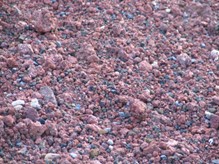
The terrain is volcanic – red and dusty – and would make an excellent stand-in for Mars. The island is largely barren. There was a small native flora prior to its discovery by humans but a significant proportion have gone extinct following the introduction of non-native plants and animals.
The volcanic landscape is geologically very young, with some evidence that there were eruptions as recent as 500 years ago. Combined with the lack of rainfall, this means that much of the island is covered in lava largely unchanged from when it first erupted from the bowels of the earth, leaving the ground covered in a sharp, loose clinker which is hard to walk on and even harder to grow in.
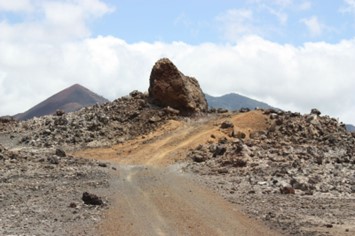
Unsurprisingly, given its proximity to the equator, it gets very hot. Daytime temperatures are in the mid-high 20s Celsius and there is little cloud cover. The rocks also radiate heat in a way that has to be felt to be believed, it’s like standing in an oven.
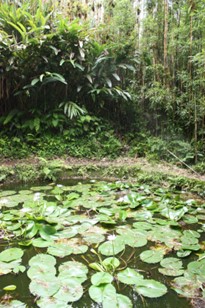
The only place where plants grow in profusion is Green Mountain. It is green due to human efforts, first begun in the early 19th century when a British navel garrison was established on the island. In 1843 Joseph Hooker visited the island and encouraged its cultivation, advising the Admiralty to appoint a gardener and import plants in order to support the island’s inhabitants and encourage rainfall to increase access to much-needed fresh water. A dew pond was constructed on the mountain in 1875 to convert the frequent mists into water and provide an emergency supply to inhabitants. Today, water is provided primarily by desalination plants.
When I visited, the only fresh food available was locally-caught tuna. Everything else was shipped in. It was a strange thing to be sat on what was technically a tropical island, eating fruit salad from a can.
It has a tiny population
About 800 people live on Ascension island. All of them are either employees or family of employees of the various organisations which operate on the island – there is no right of abode. The majority are St Helenians (Saints) while the rest are mostly British and American.
As a result there is limited infrastructure. When I visited there was one small ‘supermarket’ that was smaller than most newsagents in the UK and a handful of other shops. There is a small hospital that is only equipped to deal with minor incidents. There is no pharmacy, and if you need prescription medicines you are advised to bring them with you.
It is a military base
RAF Ascension Island is jointly operated by the RAF and the United States Space Force. In the 60s, Ascension was an integral part of the Space Race due to its tracking station whose antennas are the first to see spacecraft after they launch from Cape Canaveral. In the era of the space shuttle, the airfield provided an emergency landing site, a role it fortunately never got to play. While its role has reduced following the shuttles decomissioning, it is still used by both militaries, hosting an Anglo-American signals intelligence facility and one of four ground antennas that help operate the GPS system.
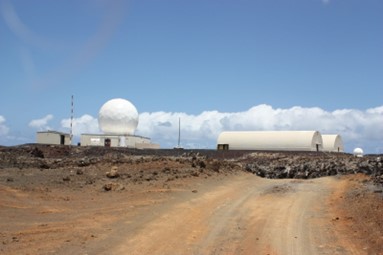
As a result of this militarisation, only military and diplomatic flights are allowed to land on Ascension. The only exception is a civilian charter flight between St Helena and the island. All flights were cancelled in 2017 due to the poor state of the runway and only resumed this year.
It is also home to various communications stations. Encompass manages the BBC’s Atlantic Relay Station on the island, providing radio service to most of Africa and South America.
It is an Overseas Territory
Ascension is part of the United Kingdom Overseas Territory of St Helena, Ascension, and Tristan da Cunha. As an Overseas Territory it has its own Constitution, laws and is internally self-governing. The UK is responsible for defence, international relations and internal security.
What this all means
Firstly, and most importantly, it’s not clear to me that the British government has the power to unilaterally decide that Ascension should hold asylum seekers and undocumented migrants. The island is self-governing, and while it is reliant on the UK, that doesn’t automatically mean the government gets to dump people on its doorstep. When this story started circulating 18 months ago, freelance journalist Andrew Connelly did what none of the mainstream media managed and actually contacted the Ascension government. They said,
There are no ongoing discussions to receive UK asylum seekers.
It’s also not clear that the US government is going to welcome the UK holding asylum seekers near one of their military bases, especially one so hard to reach with additional staff if anything were to happen.
Even if these issues are resolved, it takes over 9 hours to fly to Ascension from the UK. The only flights to the island are military flights from Brize Norton in Oxfordshire that form the Airbridge between the UK and the Falkland Islands. There are limited civilian seats, mostly used by Falklanders or their families, and they cost a lot of money.
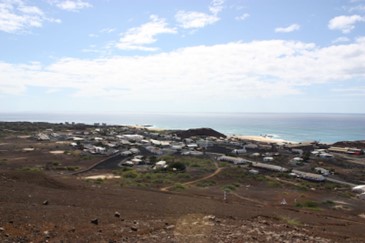
Everything must be flown or shipped in (usually from the UK or South Africa). Every single mug and spoon and bag of sugar. Every single nail and hammer and piece of plasterboard. Every single bed and toilet and door and window. Every single alarm and security light. That all costs money.
There’s no indigenous population. Everyone on the island already has a job. That means that to staff the detention facility you’d have to find people willing to work on one of the most remote islands on earth as, essentially, prison guards. And then you have to house them. And feed them. And provide medical care. And give them regular leave to go home to see their families. And ensure adequate cover while their gone. And that costs money.
Jacob Rees Mogg estimated it would cost at least £1 million per person to keep them on Ascension.
So given the astronomical costs and all the arguments against it, why does Ascension keep coming up as an option?
Why Ascension Island?
The government is trying to replicate a strategy created in Australia, which has a long-standing policy of refusing any asylum seeker arriving by boat to settle in the country. Boats are turned around and, if that’s not possible, their occupants are sent to their overseas detention centre for processing. While the numbers of boat arrivals has reduced, the reasons are unclear, and the numbers attempting to reach Australia by boat are significantly smaller than those attempting to reach the UK.
Australia has overseas processing centres on Christmas Island, Papua New Guinea and Nauru. These facilities are rife with accusations of human rights abuses. One detention centre on Manus Island, Papua New Guinea, was accused of systematically violating the UN’s convention against torture and was closed by the Papua New Guinea government in 2016 after they ruled it to be illegal. The Australian government was forced to pay $70 million in compensation to 1,905 refugees and asylum seekers for illegally detaining them in dangerous and damaging conditions. The centre on Nauru has been recently emptied, but not closed. This has come after years of accusations of inhumane treatment, most notably from Dr Peter Young, the chief psychiatrist responsible for the care of asylum seekers at the detention centres who said their treatment was akin to torture.
While the UK has many islands off its shores, few are remote enough to evade scrutiny from people concerned that these human rights abuses may be replicated. It must therefore look to its overseas territories. Most have populations who will likely object to being used as a dumping ground for the UK. Ascension is the closest island with a non-native population. It seems likely this is why it has been selected.
So what now?
I would be very surprised if Ascension ever becomes home to asylum seekers, though it’s not impossible. This government has been full of surprises over the years.
One thing that Australia has shown is that overseas detention is wildly expensive. The Refugee Council of Australia estimated it cost around $1 billion per year to hold people overseas while processing their applications. The Asylum Seeker Resource Centre published a report in 2019 that found each person cost over $573,000 each year to be processed in an offshore detention facility, compared to an average of $346,000 each year in an onshore detention facility, a saving of over $200,000 but still an incredible amount. In comparison, each person allowed to live in Australian communities on bridging visas cost $10,221 each year.
I don’t have the space to get into the details of how messed up our asylum system is. Suffice it to say, the British government has made it practically impossible to claim asylum in the UK. International law requires you to be on the soil of the country in which you wish to claim asylum – an embassy isn’t enough – so coming by boat is the only route for many desperate people. People come because they have family here and they speak the language. No amount of deterrents are going to change that fact.
More and more people will be displaced due to the effects of climate change and the social upheavals it inevitably causes. We need to have a serious conversation as a country and as a planet about how we are going to deal with this mass movement of people. But shutting our borders, ignoring our legal obligations and shipping people to tiny volcanic islands in the middle of the ocean at vast expense is not a solution.



